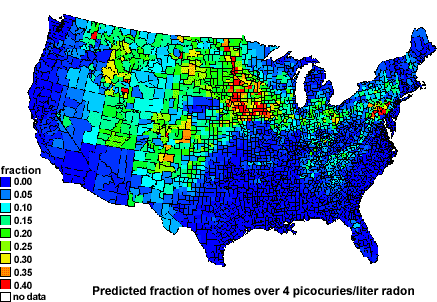| BERKELEY, CA — Radioactive
radon gas, seeping into houses from the soil below, poses a health risk to
humans in certain parts of the United States. Now, a new Web site
developed jointly by scientists at the U.S. Department of Energy's
Lawrence Berkeley National Laboratory and Columbia University, uses
advanced mathematical methods, research on radon gas infiltration, and
geologic data, to help homeowners determine when and how to take action to
reduce health risk from radon exposure.
The Radon Project Web site was developed by Phil Price of Berkeley
Lab's Environmental Energy Technologies Division, along with Andrew Gelman
and others at Columbia University’s Department of Statistics.
Radon is a naturally occurring radioactive gas, a product of
radioactive decay of radium. Studies of uranium miners have shown that
breathing high concentrations of radon can increase the risk of getting
lung cancer. Enough radon gas seeps out of soil into basements and
crawlspaces in parts of the United States to pose a health risk to people
living in homes built on that soil.

"The Radon Project Web site can help homeowners determine whether
they are breathing potentially dangerous levels of radon, and whether
those risks are high enough to warrant making measurements of their actual
exposure, or having a contractor come in right away to install measures to
reduce radon infiltration in their house," says Price.
"Policymakers can also use the site as a tool to determine optimal
policies for addressing radon health risks."
At the Radon Project Web site, users are prompted to choose their home
state and county from a U.S. map and then asked a few questions about
their basement and radon measurements that have been made in their area.
They are also asked how many smokers and non-smokers live in the house
since radon exposure increases the risk of lung cancer more for smokers
than non-smokers.
Default values for acceptable risk levels and the estimated costs of
reducing exposure to acceptable levels are automatically entered. A user
can adjust these values if he or she desires. With this information,
software calculates the probable level of radon exposure in the user's
home then displays an exposure probability curve and a simple table
showing the costs of various actions, i.e., doing nothing, short- or
long-term testing to measure radon level accurately, or immediate
remediation. Recommendations are made based on the exposure level
calculated.
Radon levels between 2 and 10 picoCuries per liter (pCi/L) probably
pose some risk and levels above 10 pCi/L are considered definitely
dangerous by experts in the field. Research suggests that between 50,000
and 100,000 homes in the U.S. have radon concentrations in living spaces
in excess of 20 pCi/L. This level is roughly equivalent to the lifetime
exposure of a uranium miner and appreciably increases cancer risk.
However, radon levels can vary tremendously even within a single county,
To cope with the uncertainty as to how much radon might be present in a
specific locale, the Radon Project Web site software employs a unique
hierarchical method of modeling.
"Hierarchical modeling allows the software to take the spatial
variability of radon into account when calculating the odds of radon
exposure where the home is located," says Price.
Price worked with other Berkeley Lab researchers, and with Gelman at
Columbia, to predict the radon distribution in almost every U.S. county.
Predictions are based on indoor radon data provided by the Environmental
Protection Agency, geologic information from the U.S. Geological Survey,
and other data.
Gelman and Price, along with Columbia graduate student Chia-yu Lin,
then developed a method for using these county predictions along with
household information to analyze radon risks and remediation costs for
individual homes. Price and Gelman developed their Web site to implement
this method.
Berkeley Lab researchers have been studying radon infiltration into
U.S. homes for more than 15 years and helped develop the currently
preferred remediation method.
A description of the theory used in the Radon Project Web site software
was published in the journal Statistical Science, v. 14, no.3, pp
305-337, "Analysis of Local Decisions Using Hierarchical Modeling,
Applied to Home Radon Measurement and Remediation," by Chia-yu Lin,
Andrew Gelman, Philip Price and David Krantz.
Additional Information:
|


